When taking a stroll in the woods or enjoying time in your backyard, you may have noticed some interesting-looking mushrooms growing on trees.
Many popular edible and medicinal mushrooms grow on trees. Maybe the ones you have come across are some of them.
Read on to learn why mushrooms grow on trees with information on 20 common edible and medicinal mushrooms that grow on trees and where to find them.
But, remember you should never consume a wild mushroom unless you’re 100% certain of its identity.
Mushroom identification apps can assist you, but it’s always best to err on the side of caution and consult a local mycologist or experienced forger before adding them to your menu.
Why Do Mushrooms Grow on Trees?
The mushrooms you see growing on trees are the visible fruiting bodies of a much larger fungus that’s growing inside the living or dead tree.
Unlike plants, fungi cannot produce their own food and need to source the nutrients they need to grow from the organic matter around them.
There are over 140,000 species of wild mushrooms worldwide, and one of the ways scientists classify them is based on how they get their nutrition and what they eat.
What fungi grow on dead trees?
Generally, the mushrooms you see growing on dead trees, stumps and branches are saprotrophic, which means they’re decomposers that feed on dead and decaying wood.
Decomposers play a vital role in ecosystems as they break down dead organic matter, creating compost that benefits the soil, trees and plants.
If you come across a mushroom that’s growing on a living tree, it’s usually parasitic. Parasitic fungi need living hosts to get the nutrients they need, and, over time, they infect the entire host, causing it to die.
What kind of mushrooms grow around trees?
There is a third type of fungus that you’ll find growing around the base of trees as their mycelium interacts with the tree’s roots.
Scientists call these mycorrhizal mushrooms, and, unlike parasitic mushrooms, they form beneficial symbiotic relationships with living trees.
In exchange for the simple sugars the tree provides, these fungi extend the range of the tree’s roots and provide extra nutrients and moisture.
Types of Mushroom That Grow on Trees
A wide range of mushrooms grow on trees, and many of them are rather extraordinary looking. But generally, there are three common types of fungi that grow on trees:
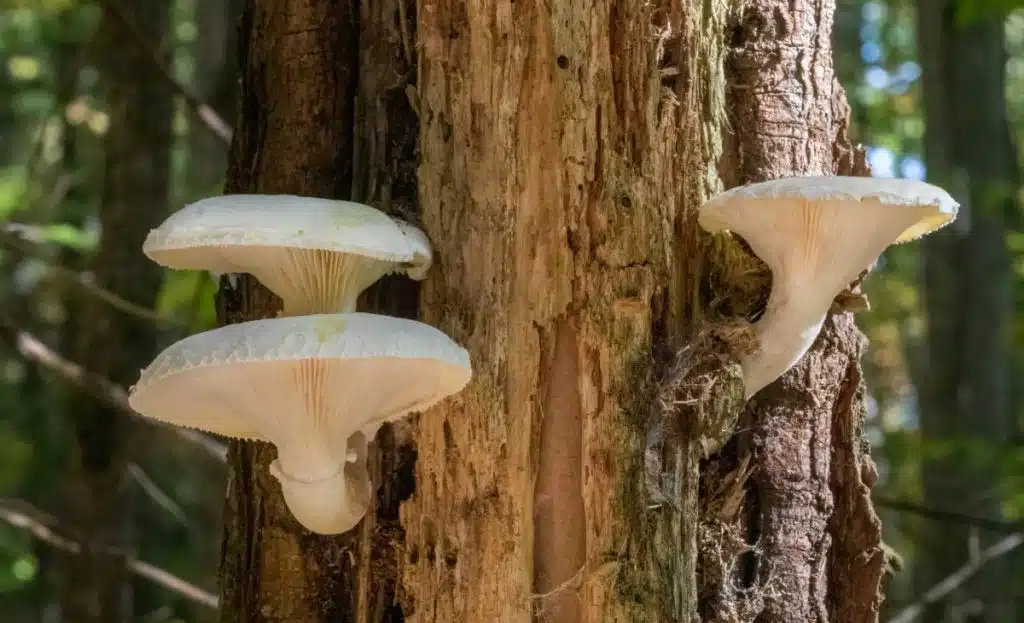
Cap Fungus
Cap fungi produce mushrooms with distinct caps and stems and are generally the most well-known type of mushroom.
Examples of common cap fungi that grow on trees are:
- Oyster mushrooms
- Shiitake mushrooms
- Honey mushrooms
- Pioppino mushrooms
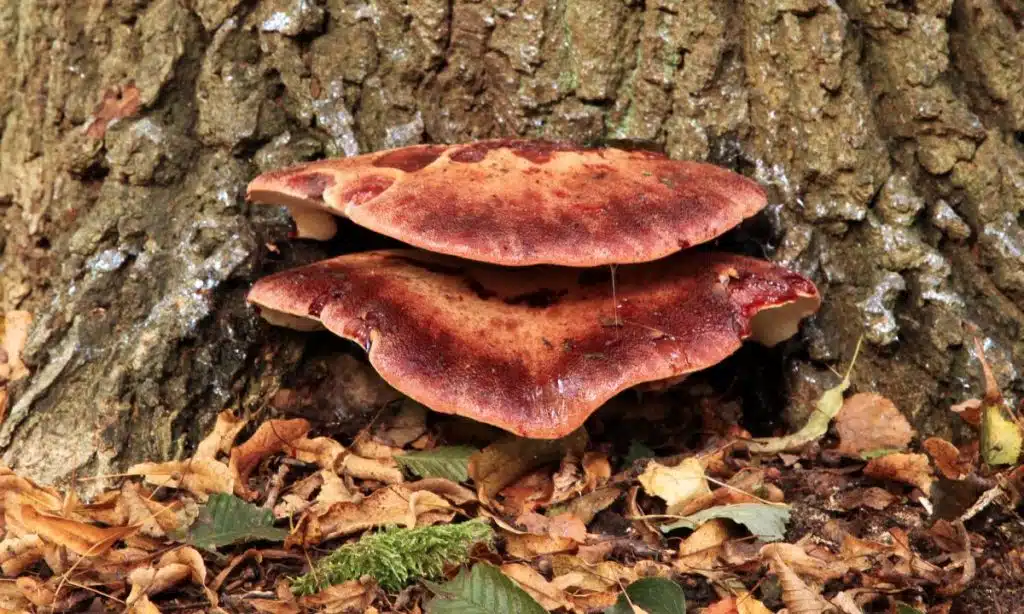
Shelf or Bracket Fungus
Shelf or bracket fungi produce one or more shelf-like projections that are their spore-producing bodies.
These projections are often woody, leathery or fleshy with pores on the underside and firmly attached to living or dead tree trunks and branches.
Many popular medicinal mushrooms are polypore bracket fungi, and common polypores that you’ll find growing on trees include:
- Chicken of the Woods
- Turkey Tail
- Dyer’s Polypore
- Reishi
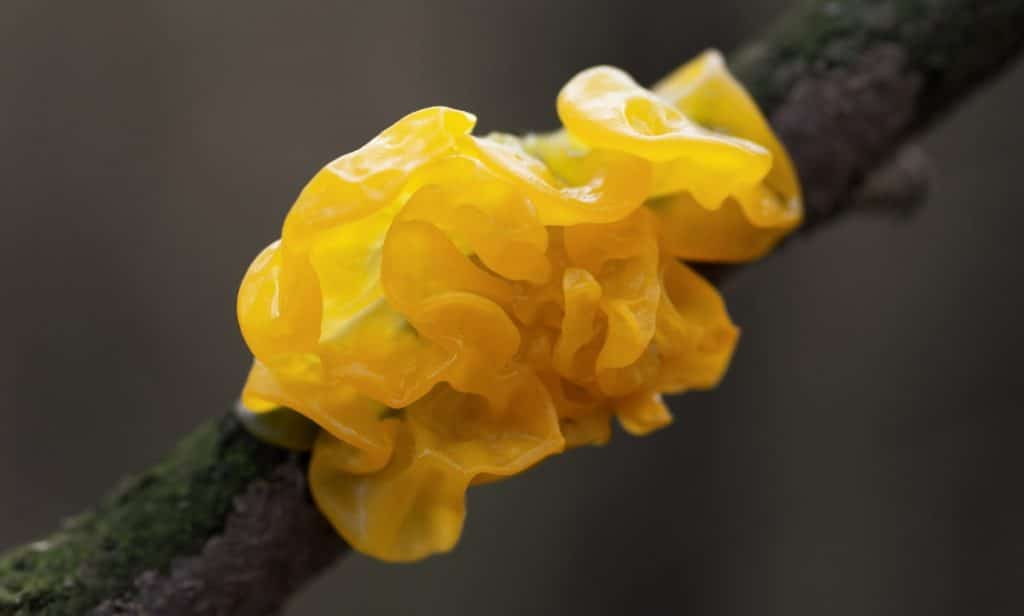
Jelly Fungus
Jelly Fungi are extremely unusual-looking tree-dwelling fungi that often have soft, rubbery or gelatinous fruiting bodies with a translucent appearance.
They come in many shapes, sizes and colors and may resemble ears, brains, blobs, sea anemones, underwater coral or wavy seaweed.
Examples of common jelly fungi that grow on trees include:
- Tremella
- Wood ear
- Witches’ Butter
20 Common Mushrooms That Grow on Trees
Many mushrooms that grow on trees are unusual and unique, making them easy to identify and ideal for beginner foragers.
So next time you are in a woodland or forest, keep a lookout for these common edible and medicinal mushrooms that grow on trees:

1. Oyster Mushrooms (Pleurotus ostreatus)
Oyster mushrooms are popular gourmet mushrooms and one of the easiest mushroom species to grow, which is possibly why they’re the second most cultivated mushroom species worldwide.
Oyster mushrooms are a favorite with chefs and are prized for their subtle flavors and meaty flesh. They also provide several health benefits.
They come in various shapes and colors, including pink, blue and yellow varieties, that taste slightly different and add interest to any meal.
Oyster mushrooms are saprotrophs, and you’ll find wild oyster mushrooms growing in clusters on decomposing hardwood logs, stumps or dead trees.
They are one of the most common edible mushrooms that grow on trees and are relatively easy to identify.
Depending on your location and the trees in your area, you could come across several different oyster mushroom species. Each species has its preferred type of hardwood substrate, but they seem to particularly like growing on dead and decaying oak and beech trees.
You’ll usually find oyster mushrooms in the fall, particularly after the first frost, but some, like phoenix oysters, prefer warmer temperatures, and you’ll find them in summer.
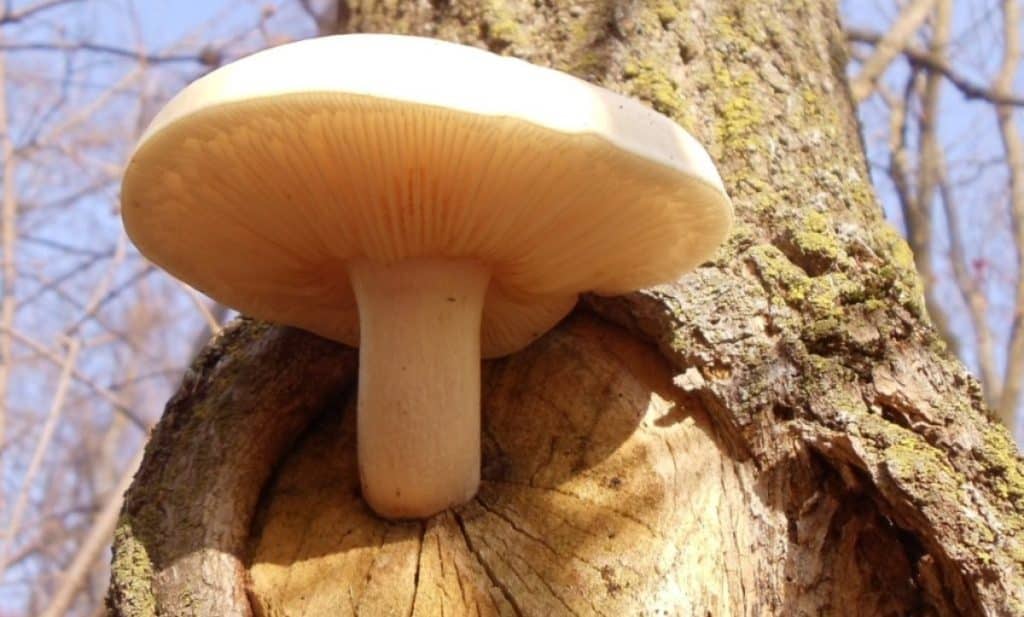
2. Elm Oyster Mushrooms (Hypsizygus ulmarius)
Elm oyster mushrooms are delicious edible mushrooms that grow high up on the trunks and branches of broadleaf hardwood trees in mixed woodlands.
Although similar in appearance to other oyster mushrooms, they do not belong to the same genus, and their scientific name, Hypsizygus ulmarius, describes where you’ll find them.
In Latin, ‘hypsi’ means high up, ‘zygus’ means a yoke, and the second word, ‘ulmarius’, means of elm trees, as elms are their favorite host trees.
They usually grow individually or in small groups from branch scars and wounds in living elms and box elders, but sometimes you’ll find them on beech, maple, willow and oak trees.
Although they usually grow on living trees, causing white rot, they can feed on dead and decaying wood. As a result, researchers have listed them as parasites and saprotrophs.
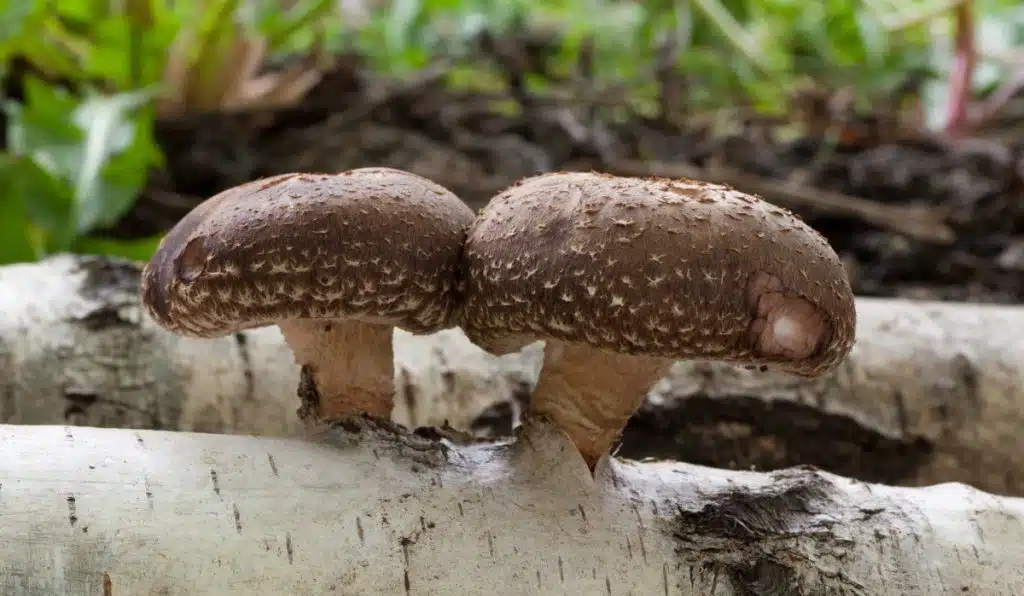
3. Shiitake (Lentinula edodes)
Shiitake mushrooms are saprotrophs and native to Southeast Asia, where you’ll find them growing on dead and decaying wood from a wide variety of deciduous trees.
Their favorite host trees include shii (giving them their name), chestnut, oak, maple, beech, sweetgum, poplar, alder, chinquapin, hornbeam, ironwood, and mulberry trees.
Shiitake mushrooms grow in groups on fallen branches in warm, moist environments and have dark-brown, umbrella-shaped caps and thin, fibrous stems.
Mushroom farmers grow shiitake mushrooms indoors and outdoors on logs or hardwood sawdust blocks.
They are sought-after culinary and medicinal mushrooms and the third most cultivated mushroom species in the world. Their rich, intense umami flavor adds depth to any dish, and vegetarians often use them as a substitute for ground beef.
Although you may not find fresh shiitake mushrooms in every grocery store, most stores stock dried shiitake mushrooms that have a more intense flavor than fresh shiitakes.
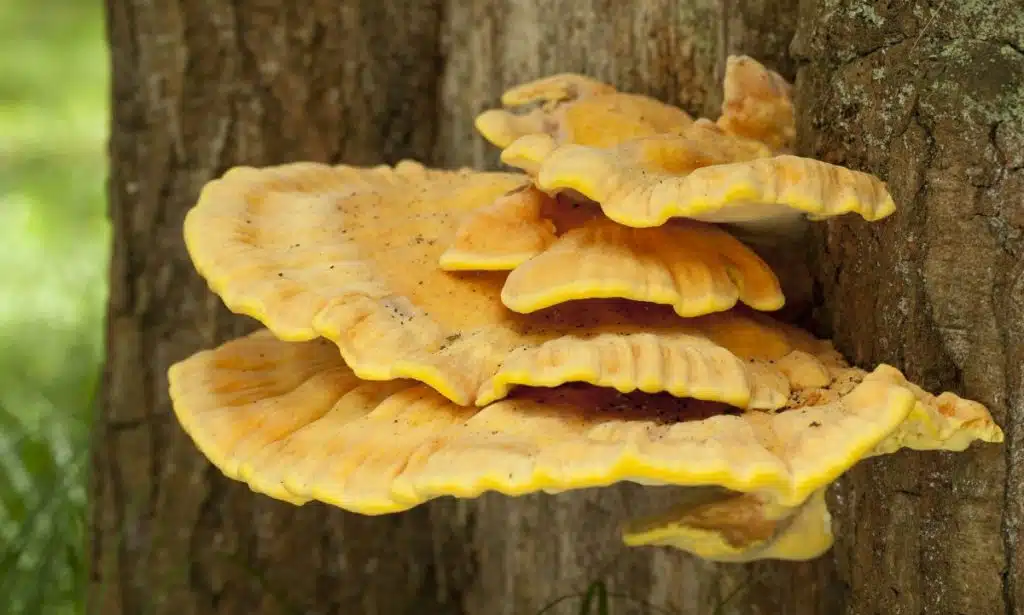
4. Chicken of the Woods (Laetiporus sulphureus)
Chicken of the woods is a striking, brightly-colored, edible bracket fungus that grows in large tiered clusters on dead and decaying trees.
They’re usually saprotrophic but occasionally parasitic on old or weak trees where they cause brown rot.
Chicken of the woods are most often found growing on stumps of deciduous hardwood trees like oaks, maples and beeches, but they’ll also grow on willow, wild cherry, sweet chestnut, and eucalyptus trees.
Fall is usually the best time to find chicken of the woods mushrooms, and they often appear in the same spot year after year until the wood is fully decomposed.
They’re very versatile in the kitchen, and many people use them as a substitute for chicken as their dense fibrous flesh has a texture similar to cooked chicken.
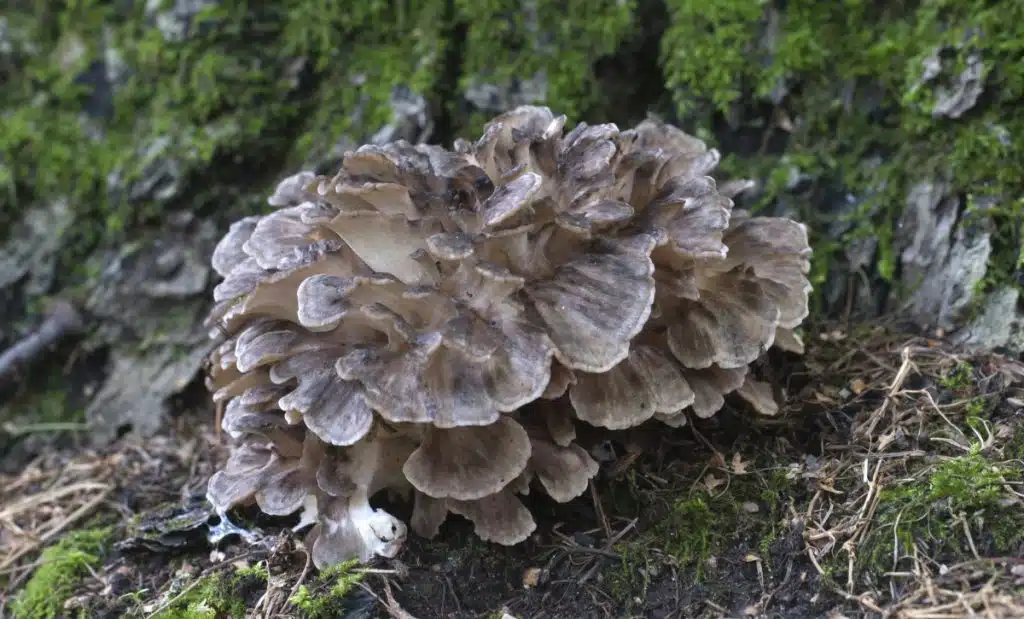
5. Maitake/Hen of the Woods (Grifola frondosa)
Maitake mushrooms grow in clusters and have flattened grayish-brown caps with wavy edges that resemble the ruffled feathers of a sitting hen, giving them the name hen of the woods.
They’re delicious edible mushrooms prized for their culinary versatility, but they also have medicinal properties.
Traditional healers in Asia have used them for centuries, and now, modern research is backing up their many health benefits.
Maitakes are commonly found in Japan, China, the northeastern United States and Canada, but they also grow in Europe and the United Kingdom.
They grow almost exclusively at the base of oak trees, although occasionally, you may find them at the base of other deciduous trees, including maple and elm trees.
Maitake are weakly parasitic, feeding on the roots of aging oak trees, and become saprotrophic when the trees die or fall over.
Although they cause white rot in living tree roots, weakening them slowly over time, it is not a quick death sentence, and they seem to protect their host trees from other parasitic fungi.
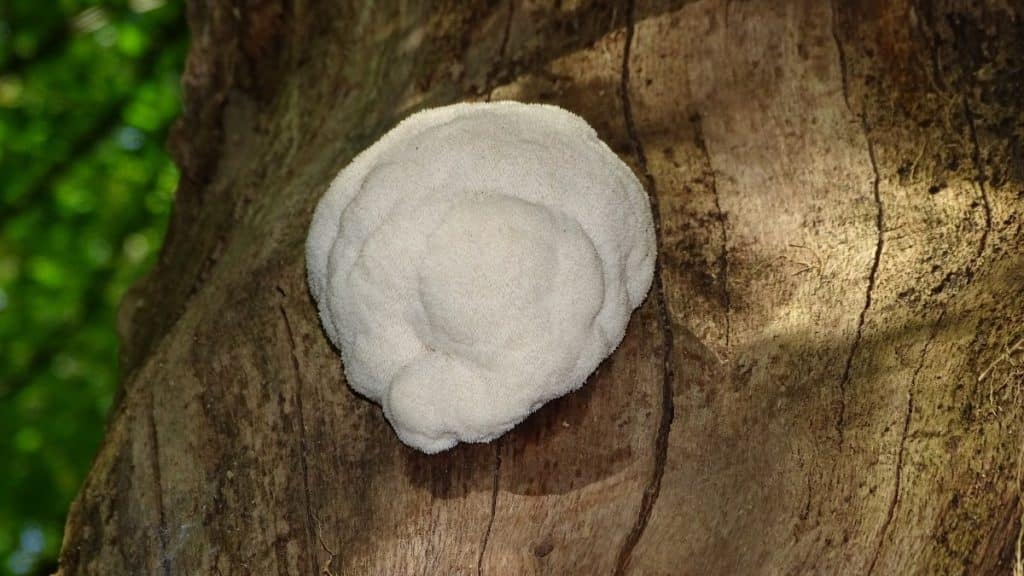
6. Lion’s Mane (Hericium erinaceus)
Lion’s mane mushrooms are sought-after edible and medicinal mushrooms that are becoming increasingly popular as people learn about their remarkable health benefits.
Lion’s mane are parasitic and saprotrophic and grow on living and dead trees in deciduous woodlands throughout the northern hemisphere.
You’ll often find these unusual-looking mushrooms growing high up in elderly, dying or dead trees or from wounds on trees where branches have broken off, leaving exposed wood.
The best time to forage for lion’s mane mushrooms is late summer and fall, and their favorite hardwoods are oak, beech, maple, sycamore and walnut trees.
Lion’s mane will grow from the same tree for many seasons, so once you find some, you’ll know where to look the following year.
They’re excellent for cooking, and their unique seafood-like flavor and tender, meaty texture make them exceptionally versatile.
Our article on how to cook lion’s mane mushrooms has plenty of ideas for cooking them with a few quick and easy recipes.

7. Enoki/Velvet Foot Mushroom (Flammulina velutipes)
Enoki mushrooms are popular edible mushrooms native to East Asia but commonly cultivated in bottles worldwide.
Growers use special conditions to grow enokis to produce the long white stems and tiny caps sought after by chefs.
Wild enoki mushrooms are very different from cultivated enoki.
They have glossy, moist-looking brown caps and a fuzzy coating at the base of their stems that’s usually darker than the stem, which is why they’re often called velvet foot mushrooms.
Enokis are saprotrophic and grow in dense clusters on dead and dying hardwood trees.
You’ll usually find them growing on elms and willows in late fall or early spring, but they also grow on aspen, poplar, birch, persimmon, ash, mulberry and maple trees.
In Asia, their preferred host trees are Chinese hackberry or enoki trees, giving them the name enokitake.
Although wild enoki is just as delicious as cultivated enoki mushrooms, wild enoki has a toxic look-alike that makes foraging dangerous.

8. Chestnut Mushrooms (Pholiota adiposa)
People have been enjoying chestnut mushrooms for centuries in Japan, but they’re still relatively unknown in the Western world, although they’re gaining popularity daily.
In some stores, darker versions of the common button or cremini mushrooms (Agaricus bisporus) are sometimes marketed as chestnut mushrooms, creating confusion.
But Pholiota adiposa chestnut mushrooms, also called cinnamon caps, fat pholiota or numerisugitake, are nothing like button mushrooms.
They have beautiful colors and long, crisp edible stems, and when cooked correctly, the cap and stem remain firm and crisp.
In the wild, chestnut mushrooms grow in dense clusters on living and dead trees as they’re saprotrophic and occasionally parasitic.
However, they tend to grow better on dead and decaying wood, and you’ll most often find them growing on dead or dying beech trunks, stumps, and fallen branches from fall to early spring.
Although beech is their favorite, they also grow on poplars, oaks and other broadleaf hardwoods in parts of Europe, Britain and Ireland.
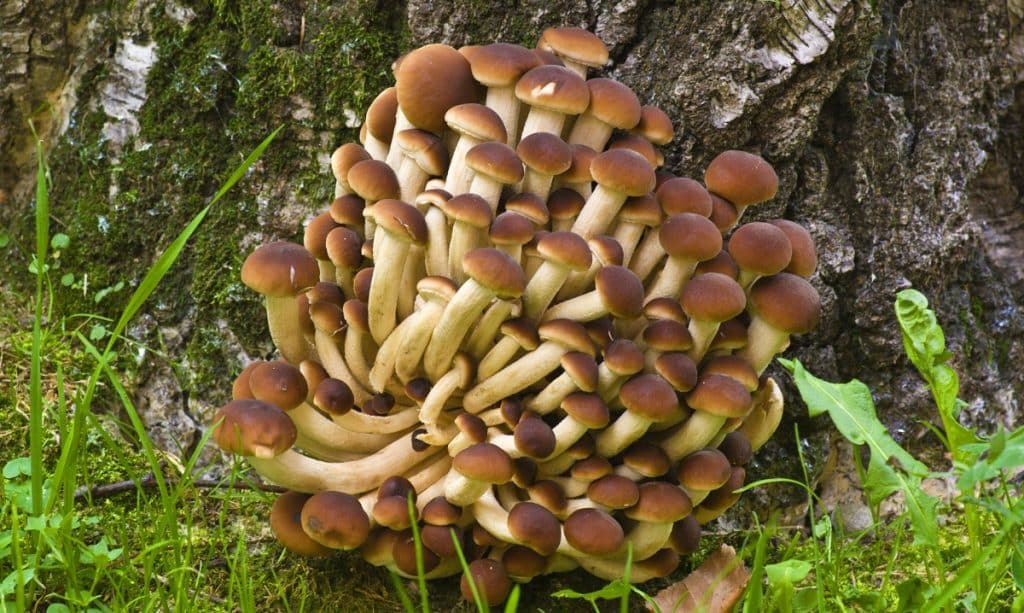
9. Pioppino Mushrooms (Agrocybe aegerita)
Pioppino are delicious edible mushrooms with long white or cream stems and small light brown caps.
People in Europe and Asia have cultivated them for millennia for culinary and medicinal purposes.
Although not often found in grocery stores, you may come across them at farmer’s markets.
You’ll usually find wild pioppino mushrooms growing in late summer and fall in southern Europe, Asia, Australia, Mexico and the southeastern USA.
They’re saprotrophs that grow in large clusters on decaying hardwood trees. Black poplars are their favorite host trees, and because of this, they’re often called black poplar mushrooms.
However, you’ll also find pioppino mushrooms on other broadleaf trees, including willows, cottonwoods, chestnuts, elms and maples.
Sometimes they appear to grow out of the ground, but they’re actually feeding on the tree’s dead roots buried in soil or covered with leaf mulch.
Correctly identifying them in the wild can be challenging. It’s not always easy to tell them apart from other Agrocybe mushrooms, but their fondness for poplars and willow trees makes it a little easier.
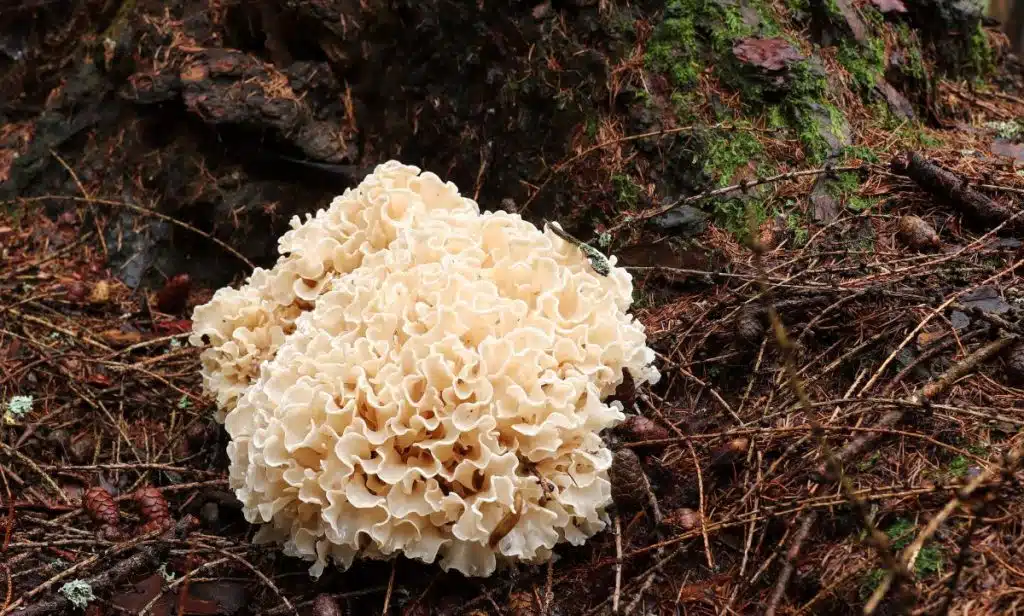
10. Cauliflower Mushrooms (Sparassis crispa)
Cauliflower mushrooms are unique-looking edible mushrooms that look like a head of cauliflower, giving them their name.
Known to be one of the tastiest wild mushrooms, they range in color from white to light brown and have a delicate, nutty flavor.
Cauliflower mushrooms are versatile in the kitchen and delicious when baked or fried. They’re also commonly used to add flavor and texture to soups and stews.
They are parasites that feed on the roots of coniferous trees and occasionally other softwoods. But they’re only weakly parasitic, and trees live for many years supporting this fungus.
As they feed on tree roots, you’ll always find them growing at the base of trees and never from the trunk.
Cauliflower mushrooms are widespread and usually grow at the edges of conifer forests in Britain, Ireland, Europe and North America.
They can grow up to 24 inches (60 cm) in diameter and weigh several kilograms but are best eaten when young and fresh before they begin turning brown.

11. Chaga (Inonotus obliquus)
Chaga is a strange-looking parasitic fungus usually found on birch tree trunks in cold climates.
The large chaga mass you see on tree trunks, resembling a chunk of burnt charcoal, is a dense mass of mushroom mycelium and wood lignans from the host tree.
This dense black mass is not the fruiting body of the fungus. The fruiting body is a flat, layered mass that usually forms under the bark of trees and is seldom seen.
Harvesting chaga from the outside of the tree does not kill the fungus, as the mycelium is still alive inside the tree.
Chaga is a medicinal fungus that people usually consume as tea or powdered and added to beverages or meals.
It’s packed with antioxidants and best known for its immune-boosting and cancer-fighting properties, but it has many more health benefits.
You’ll find chaga year-round, but foragers recommend harvesting it in late fall or winter when it goes dormant after the summer season and is full of stored nutrients.
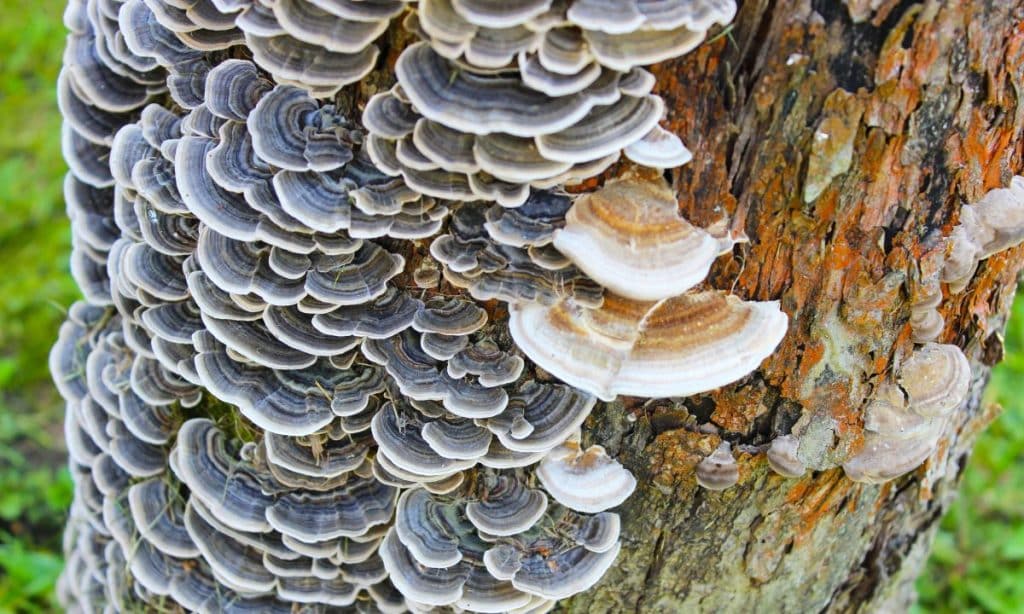
12. Turkey Tail (Trametes versicolor)
Turkey tail mushrooms are easy-to-identify, saprotrophic, bracket fungi that grow year-round.
Best known for strengthening the immune system and helping fight some cancers, turkey tail mushrooms are some of the most well-researched medicinal mushrooms with proven health benefits.
Like chaga mushrooms, turkey tails are woody, making them inedible, and they’re commonly consumed as tea or dried and ground into a powder.
They’re one of the most common medicinal mushrooms found by forgers worldwide and grow abundantly in clusters on fallen logs and branches or at the base of dead stumps.
Their caps have concentric rings of various colors, including white, shades of red and orange, and even dark brown.
As their colors are highly variable, color shouldn’t be the only way you identify turkey tail mushrooms.
Apart from highly contrasted rings of concentric colors, look for thin, flexible caps with a fuzzy or velvety texture on top and tiny pores on the underside.
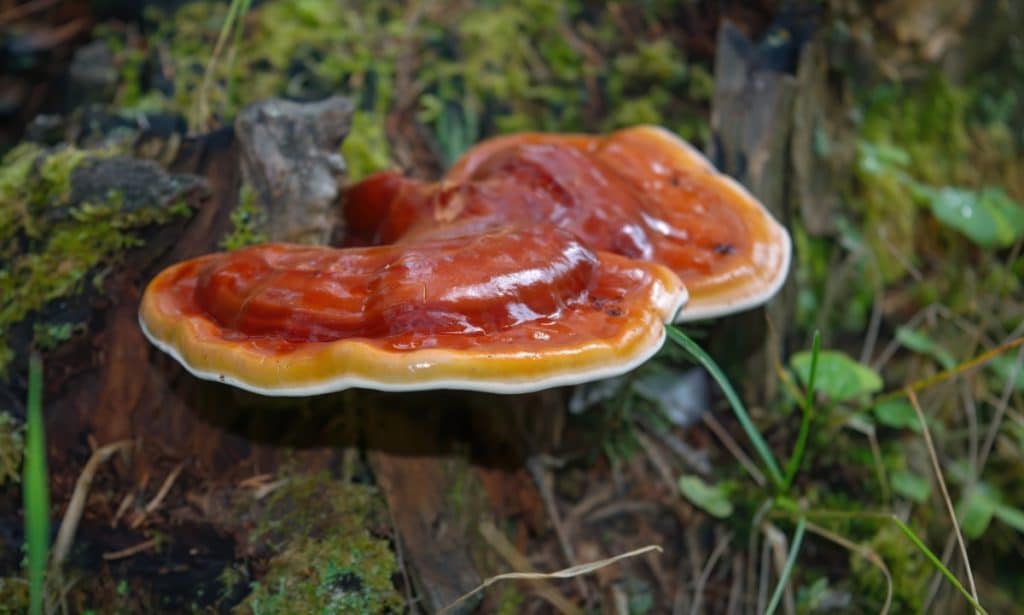
13. Reishi (Ganoderma lucidum)
Reishi is another mushroom species with impressive health benefits and a long history of medicinal use.
They’re saprotrophic shelf or bracket fungi that grow at the base of dead or dying trees and especially enjoy old stumps. Like turkey tails, their unique appearance makes them relatively easy to identify.
They have scallop-shaped shiny caps with tree-like rings that are deep red to brown in the center and lighten to orange, yellow or white toward the edges when young.
As they mature, their colors fade, becoming a general brownish color, making them a little harder to identify.
There are over 80 species of reishi mushrooms worldwide, and while they generally prefer to grow on hardwoods like oak, elm, beech and maple, some species prefer conifers.
The best time to find younger reishi is from late summer to fall, but you’ll often come across older mushrooms year-round.

14. Honey Mushroom(Armillaria mellea)
Honey mushrooms are small edible mushrooms that grow in dense clusters at the base of living trees and dead stumps.
They have honey-colored caps and long stems that are often fused at the base.
They sometimes appear to be growing out of the ground, but are really growing on buried roots or decomposing wood.
Honey mushrooms are very common in urban backyards from late summer to fall and are often found on hardwood trees like oak, beech, maple, birch, and elm.
The honey mushroom is another fungus that researchers consider both parasitic and saprophytic.
It can grow as a parasite on living trees, infesting their roots and causing root rot that, with time, kills the tree. But also thrive on dead and decaying wood and often grow around old stumps.

15. Tremella (Tremella fuciformis)
Tremella mushrooms are a type of jelly fungus. They’re best known for their skin-rejuvenating properties, and in China, they’re one of the most cultivated mushroom species.
These unique, edible mushrooms enjoy humid tropical conditions and grow on decomposing logs and branches from broadleaf trees in tropical and subtropical regions worldwide.
Tremella mushrooms look like sea anemones with lots of translucent white branching fronds or lobes attached to a central base. They have a soft jelly-like texture that’s slimy when wet.
Wild tremella are much smaller than cultivated tremella and seldom get larger than 2.95 inches (7.5 cm) across and 1.57 inches (4 cm) high.
What makes these mushrooms unique is their water-retaining ability and the fact that eating tremella mushrooms helps make skin healthy, supple and soft.
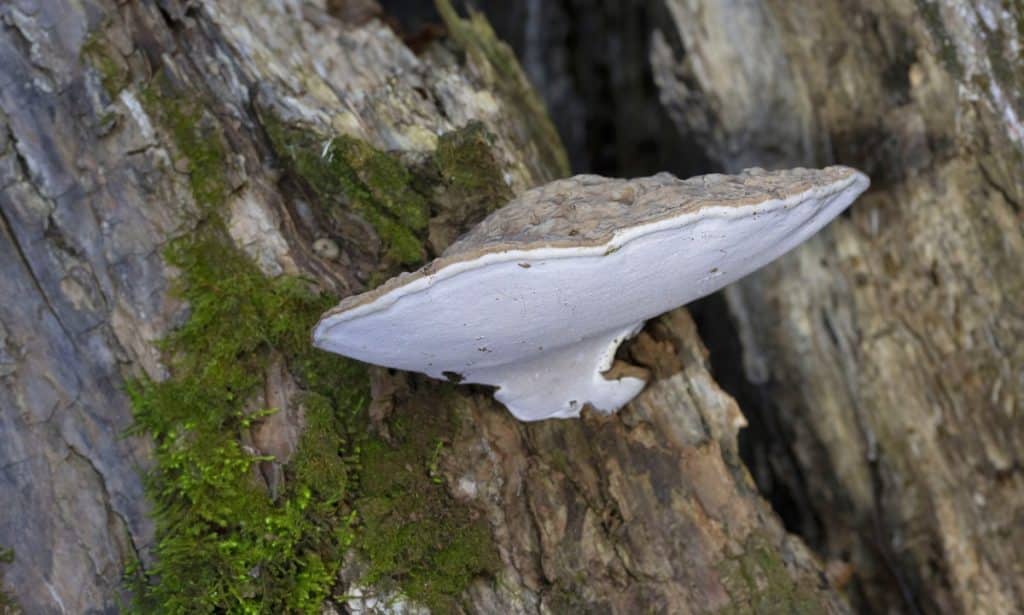
16. Artist’s Conk (Ganoderma applanatum)
The artist’s conk is a common grayish-brown bracket fungus found on living and dead hardwood trees in backyards, woodlands and forests worldwide.
Initially, this fungus is parasitic, causing heartwood and sapwood rot in living oak, maple, horse chestnut, willow, and elm trees, which ultimately results in death.
Once the tree is dead, it becomes saprotrophic, consuming and decaying the dead wood.
Artist’s conk mushrooms can grow on the same tree trunk for several years, creating massive, fan-shaped fruiting bodies that range from 2 to 30 inches (5 to 75 cm) in diameter and up to 4 inches (10 cm) thick.
The underside of the fan-shaped conk is white, and when scratched, it stains brown, allowing you to draw, sketch or write on them with any pointed object, hence giving them their name.
When you have finished sketching, let the conk dry with the underside facing up, as this will preserve your artwork for years.
Some artists like to apply additional varnish or a sealant, but this is optional as the mushroom canvas will last for years, with or without varnish.
Artist conks are not just great canvases, they’re also potent medicinal mushrooms with similar health benefits to reishi mushrooms.
As they’re hard and inedible, consuming them as a tincture or tea is the best way to access their health benefits.
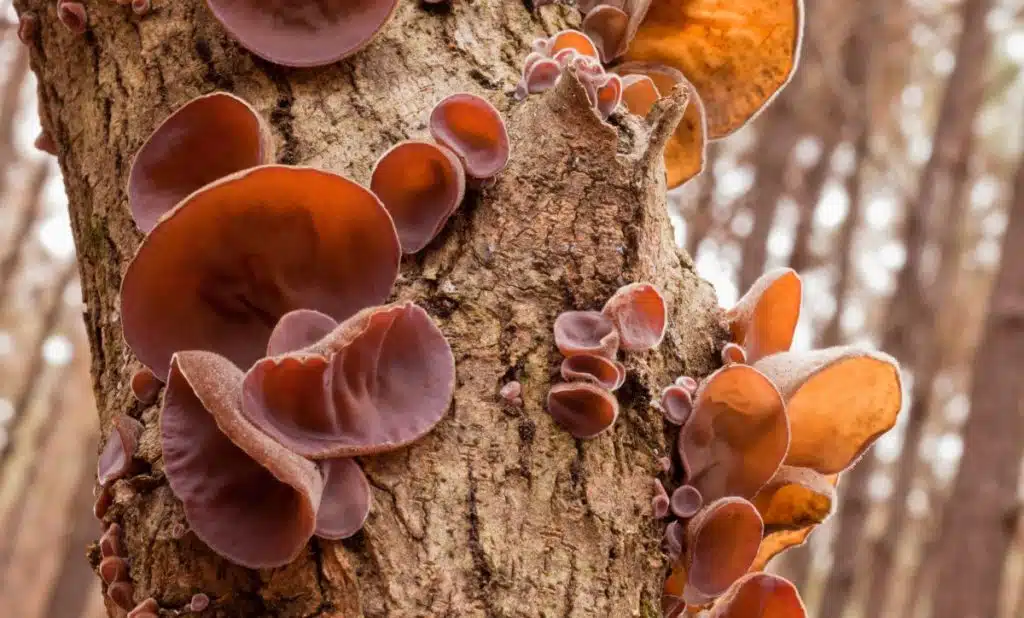
17. Wood Ear (Auricularia auricula-judae)
The wood ear is an unusual-looking, brown jelly fungus with an ear-like shape that grows in clusters on dead and dying branches.
You’ll usually find the wood ear, or jelly ear fungus, in damp, shady conditions on dead elder stumps or fallen branches.
Although elder trees are its favorite host, they occasionally grow on other hardwoods, especially beech, sycamore and ash.
The wood ear is edible and sometimes used in stir-fries and soups to add a unique chewy texture. But it does not add much flavor.
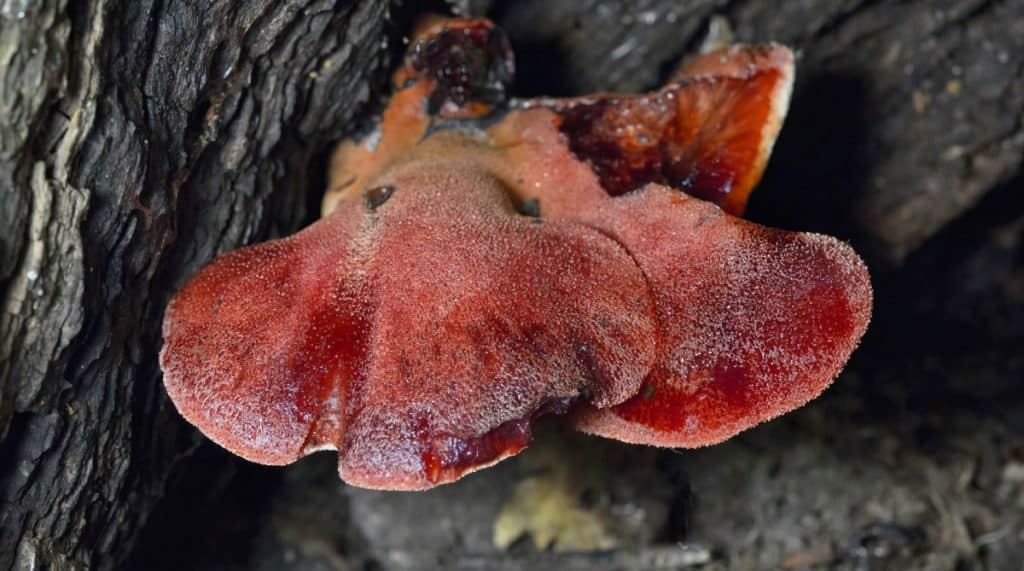
18. Beefsteak Fungus (Fistulina hepatica)
This unique, red mushroom, also known as the ox tongue mushroom or poor man’s steak, usually grows near the base of oak or sweet chestnut tree trunks.
The beefsteak fungus is parasitic, causing brown rot in the host tree that makes the wood richer and darker. The infected wood is extremely popular with furniture manufacturers.
These relatively rare bracket fungi are deep red and look like a tongue or piece of raw steak sticking out of the side of the tree trunk.
The inner flesh is thick, juicy and meaty, resembling raw steak and when it’s cut open, it often oozes red, blood-like juice.
Unlike many other mushrooms, the beefsteak fungus is often enjoyed raw. People describe raw beefsteak fungus as slightly tart, tender and a little chewy.

19. Dyer’s Polypore (Phaeolus schweinitzii)
The dyer’s polypore is an inedible, shelf fungus that’s parasitic on the roots of coniferous trees, especially pines and spruces.
It causes butt and heartwood rot in the root system and lower part of the tree, weakening the tree and sometimes causing a hollow tree base.
You’ll come across the dyer’s polypore growing at the base of trees in cool, moist conifer forests in Europe, the Americas, Asia, and Oceania.
Because they feed on the tree’s roots, these mushrooms often look like they are growing out of the ground.
When young, the dyer’s polypore is bright yellow and orange, but as it gets older, the entire mushroom fades to a dark brown color.
The entire surface of the cap is fuzzy and looks similar to velvet, which is why people often refer to it as the velvet top fungus.
People use this fungus to produce natural dyes, hence its name. It produces dyes with a wide range of earthy colors that vary depending on the age of the mushroom.
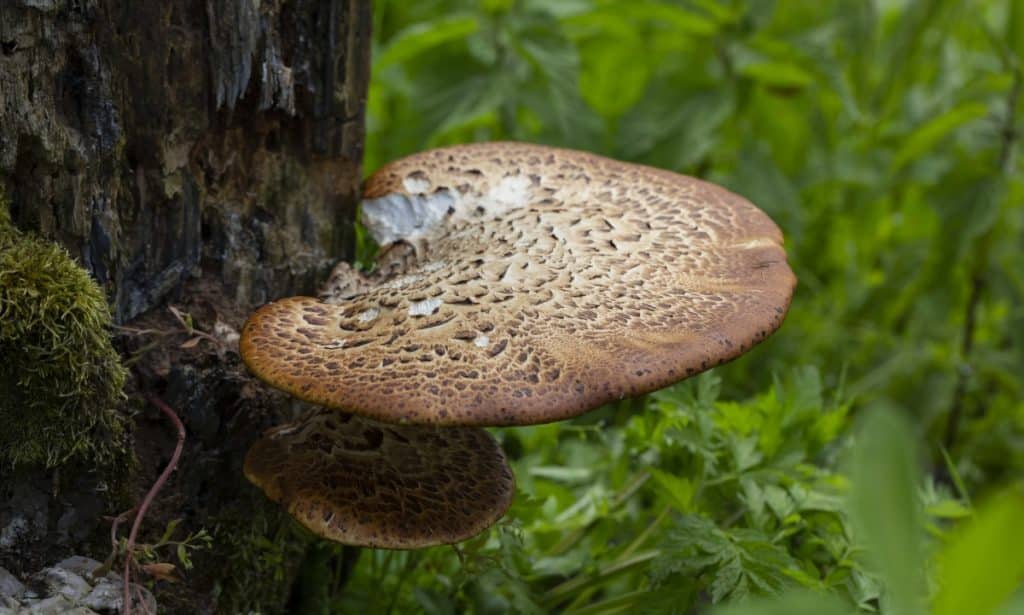
20. Pheasant Back/Dryad’s saddle (Cerioporus squamosus)
Pheasants’ backs are edible bracket or shelf fungi that are parasitic on old dying trees but also saprotrophic, decaying the wood when the tree dies.
Their favorite host trees are elm, beech and sycamore, but you’ll also find them growing on oak, maple and ash trees.
These mushrooms usually appear singly or in small groups of two or three mushrooms and can grow quite large with caps that are 3 to 12 inches (8 to 30 cm) across or 27 inches (70cm) in diameter.
They have scales on the top of their fan or kidney-shaped caps that grow in a concentric, radial pattern resembling a pheasant’s feathers, thus giving them their name.
When young, with barely visible pores and caps less than 8 cm across, they are delicious, especially when thinly sliced and sauteed in olive oil and butter.
Older pheasant back mushrooms become extremely tough and are best used to make mushroom stock.
Common Mushrooms That Grow on Living Tree Roots
Earlier in this article, we briefly mentioned mycorrhizal fungi that form symbiotic relationships with tree roots.
Many mycorrhizal species produce delicious edible mushrooms that are sought after and some of the most expensive mushrooms in the world.
They’re often challenging or impossible to cultivate because they need a relationship with living tree roots to thrive.
Common edible mushrooms that you’ll come across growing on living tree roots include:
- Chanterelles – Chanterelle mushrooms are striking, bright yellow to orange mushrooms that form associations with many different trees, but their favorite hosts are oak, maple, poplar, beech and birch trees.
- Porcini – Porcini mushrooms are large, meaty mushrooms sought after by chefs and usually found around spruces, their favorite host trees, or other conifers like pine, fir and hemlock.
- Hedgehog Mushrooms – Hedgehog mushrooms are delicious, unusual-looking mushrooms that often form associations with scots pine, hemlock and spruce but occasionally use beech, birch and oak trees as hosts.
- Morels – Morel mushrooms are sought after for their unique texture and nutty-flavor. They are very adaptable and form associations with various trees, but their favorite hosts are ash, elm, sycamore, apple and wild cherry trees.
- Saffron Milkcaps – Saffron milkcaps are tasty, crunchy mushrooms with distinctive orange gills that form associations with pine trees.
Final Thoughts
Mushrooms that grow on trees are often wood-decaying mushrooms that play a crucial role in the ecosystem.
And although some parasitic mushrooms are deadly for their host trees, they also play a role in the ecosystem and usually only prey on old, weak or sick trees.
Many mushrooms that grow on or around trees are sought-after culinary or medicinal mushrooms.
And if they thrive on dead and decaying organic matter, you can often grow them on hardwood-based substrates.
To learn more about different mushrooms and how to use them, visit our Mushroom Education Hub.
And if you want to learn how to grow wood-loving mushrooms at home, our Mushroom Growing Hub has several resources to help you.
